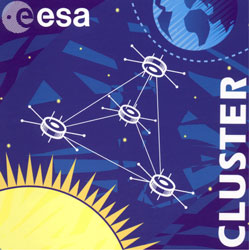

![]()
![]()
MissionThe Cluster mission is a cornerstone of the European Space Agency's science program, involving four identical spacecraft, each equipped with a complement of 11 scientific instruments. These instruments measure the magnetic and electric fields and the particles in the ambient medium. MPE has prime responsibility for the
Electron Drift Instrument (EDI), and plays a large role in the
Cluster Ion Spectrometer (CIS).
The satellites were successfully launched pairwise with two Russian Soyuz-Fregate launchers from Baikonur in July and August 2000.
The four satellites fly in formation along an eccentric earth orbit that takes them from a perigee altitude of 20.000 km to an apogee distance of about 120.000 km. Separation distances between the spacecraft vary between a few hundred km and 20.000 km.
Goals
The Cluster mission will investigate the outer reaches of the Earth's magnetosphere, which is created by the impact of the solar wind onto the magnetic field of the Earth. The solar wind is a stream of electrically charged particles which approaches the earth with speeds of typically 400 km/s. Because charged particles are deflected by magnetic fields, the magnetic field of the Earth is an obstacle that the solar wind cannot simply penetrate. Instead it flows around it, creating a boundary, called the magnetopause, that ideally completely separates the earth magnetic field and the solar wind.
In reality, that separation is not perfect, and the processes that cause the deviation from ideal behavior are at the heart of the Cluster mission.
Why four spacecraft?
Take as an analogon the weather, and the spacecraft as a mobile weather station, equipped with instruments to measure the temperature, pressure, windspeed, and precipitation. As those parameters can vary rapidly with horizontal and vertical distance, you need many stations in close proximity to describe the situation. Two stations allow inferring variations along the line between the spacecraft. Three always form a plane. Four is the smallest number of points that can be arranged in three dimensions, allowing inferences in all spatial dimensions.
The magnetopause itself is also a good example to illustrate the need for multi-point measurements. As mentioned above, the magnetopause is like a roof that should keep the rain (the solar wind) from entering the house (the magnetosphere). We know from earlier observations that the roof leaks; it has holes. With a single spacecraft flying through the roof you may encounter such a hole, but you wouldn't know how wide it is, and how far away the next hole is. And thus you couldn't tell how much rain got in. You need a fleet of closely spaced spacecraft to get the answer.
![]() Kennzeichnet externe Links
Kennzeichnet externe Links